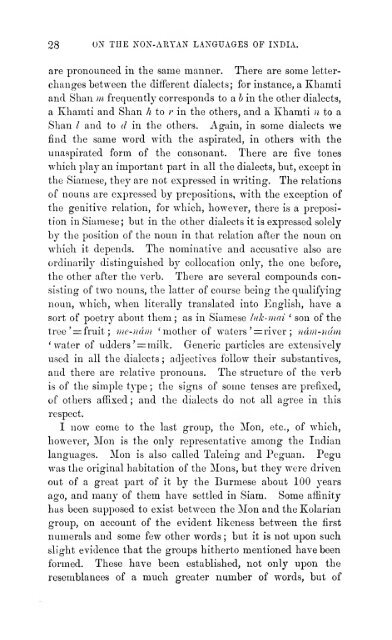Create successful ePaper yourself
Turn your PDF publications into a flip-book with our unique Google optimized e-Paper software.
28<br />
ON THE NON-ARYAN LANGUAGES OF INDIA.<br />
are pronounced in <strong>the</strong> same manner. There are some letterchanges<br />
between <strong>the</strong> different dialects; for instance, a Khamti<br />
and Shan m frequently corresponds to a J in <strong>the</strong> o<strong>the</strong>r dialects,<br />
a Khamti and Shan h to r in <strong>the</strong> o<strong>the</strong>rs, and a Khamti n to a<br />
Shan I and to d in <strong>the</strong> o<strong>the</strong>rs. Again, in some dialects we<br />
find <strong>the</strong> same word with <strong>the</strong> aspirated, in o<strong>the</strong>rs with <strong>the</strong><br />
unaspirated form <strong>of</strong> <strong>the</strong> consonant. There are five tones<br />
which play an important part in all <strong>the</strong> dialects, but, except in<br />
<strong>the</strong> Siamese, <strong>the</strong>y are not expressed in writing. The relations<br />
<strong>of</strong> nouns are expressed by prepositions, with <strong>the</strong> exception <strong>of</strong><br />
<strong>the</strong> genitive relation, for which, however, <strong>the</strong>re is a preposi-<br />
tion in Siamese; but in <strong>the</strong> o<strong>the</strong>r dialects it is expressed solely<br />
by <strong>the</strong> position <strong>of</strong> <strong>the</strong> noun in that relation after <strong>the</strong> noun on<br />
Avhich it depends. The nominative and accusative also are<br />
ordinaril}^ distinguished by collocation only, <strong>the</strong> one before,<br />
<strong>the</strong> o<strong>the</strong>r after <strong>the</strong> verb. There are several compounds con-<br />
sisting <strong>of</strong> two nouns, <strong>the</strong> latter <strong>of</strong> course being <strong>the</strong> qualifying<br />
noun, which, when literally translated into English, have a<br />
sort <strong>of</strong> poetry about <strong>the</strong>m ; as in Siamese luk-mai ' son <strong>of</strong> <strong>the</strong><br />
tree' = fruit; me-ndm 'mo<strong>the</strong>r <strong>of</strong> waters ' =river ; ndm-ndm<br />
'water <strong>of</strong> udders ' =<br />
milk. Generic particles are extensively<br />
used in all <strong>the</strong> dialects ; adjectives follow <strong>the</strong>ir substantives,<br />
and <strong>the</strong>re are relative pronouns. The structure <strong>of</strong> <strong>the</strong> verb<br />
is <strong>of</strong> <strong>the</strong> simple type ; <strong>the</strong> signs <strong>of</strong> some tenses are prefixed,<br />
<strong>of</strong> o<strong>the</strong>rs afiixed; and <strong>the</strong> dialects do not all agree in this<br />
respect.<br />
I now come to <strong>the</strong> last group, <strong>the</strong> Mon, etc., <strong>of</strong> which,<br />
however, Mon is <strong>the</strong> only representative among <strong>the</strong> <strong>India</strong>n<br />
<strong>languages</strong>. Mon is also called Talcing and Peguan. Pegu<br />
was <strong>the</strong> original habitation <strong>of</strong> <strong>the</strong> Mons, but <strong>the</strong>y were driven<br />
out <strong>of</strong> a great part <strong>of</strong> it by <strong>the</strong> Burmese about 100 years<br />
ago, and many <strong>of</strong> <strong>the</strong>m have settled in Siam. Some affinity<br />
has been supposed to exist between <strong>the</strong> Mon and <strong>the</strong> Kolarian<br />
group, on account <strong>of</strong> <strong>the</strong> evident likeness between <strong>the</strong> first<br />
numerals and some few o<strong>the</strong>r words ; but it is not upon such<br />
slight evidence that <strong>the</strong> groups hi<strong>the</strong>rto mentioned have been<br />
formed. These have been established, not only upon <strong>the</strong><br />
resemblances <strong>of</strong> a much greater number <strong>of</strong> words, but <strong>of</strong>

















